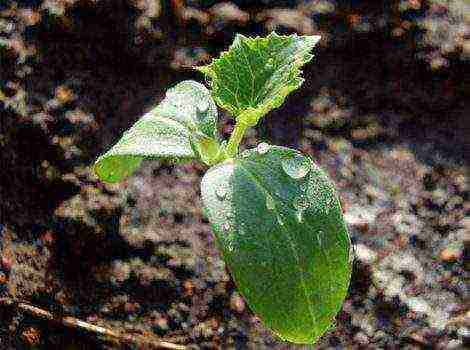Content [show]
Cultivation of thyme in central Russia and the Urals
Thyme, also known as thyme or oregano, is a widespread, perennial semi-shrub or creeping plant that grows throughout Eurasia, as well as in the Mediterranean, Scandinavia and other countries with a temperate climate.
Briefly about thyme The main qualities of thyme
The main features of thyme:
- prefers sandy, rocky soil;
- grows well on the ground with an admixture of chernozem, in the steppe and dry forests, on the rocky slopes of mountains and hills;
- loves a lot of sunlight;
- hardy;
- drought-resistant.
The value of thyme, first of all, lies in its medicinal qualities, but a pleasant aroma also adds advantages to this plant, especially among summer residents and gardeners. It is put into food as a seasoning, tea is brewed, added to pillow stuffing, used in perfumery. Thyme has many bactericidal and expectorant properties, which make it possible to use it in the treatment of various diseases. A wonderful honey plant, bees never bypass it.
Wild thyme has been cultivated for a long time so that it can be grown not only at home or in the garden, but also on an industrial scale. It takes root well and multiplies easily, unpretentious. You can sow with seeds, and also divide the bush.
Due to its undemanding nature, the cultivation of thyme is possible on almost any soil, but still prefers light nutritious, non-acidic substrates. The clayey soil is completely unsuitable for him, since the stagnation of water in it is detrimental to thyme.
Diseases and pests of thyme are not terrible. The second are scared off by its spicy aroma, it is also resistant to diseases. Only improper growing conditions and care can cause harm, for example, gray mold damage due to waterlogging. To prevent this from happening, you need to constantly monitor the moisture level and water sparingly.
Occasionally, young shoots of thyme can spoil aphids, which are easy to fight with the help of such a solution: dilute 1 tablespoon of soda ash in a liter of water, add laundry soap, strain and process infected bushes. Poisons are undesirable, since thyme is used for food.
Cultivation of thyme in the Moscow region Cultivation of thyme in the Moscow region
The climate of the Moscow region is moderately continental. There are relatively warm dry summers and frosty snowy winters here. Sod-podzolic soils prevail on the territory of the Moscow region, which are widespread throughout the region, with the exception of the southern outskirts. This is a nutritious fertile land suitable for growing thyme. The south and southwest are represented by gray forest chernozems - slightly acidic, with a high humus content, suitable for agriculture.
On such soils, thyme takes root well, so its cultivation does not require a lot of time. It winters well under snow cover, in summer it feels great in a drained substrate (it is important that excess moisture does not stagnate around it) in an open sunny area. In nature, you can meet him on the outskirts of forests, in open glades, hills.
Thyme loves rocky terrain and hills
Of the many species in the Moscow region, the most common cultivation of two of them - common thyme and creeping. Reproduction is simple: by seeds or by dividing the bush. Except for medical purposes, thyme beds are grown to decorate the garden.The carpet of its small flowers fits perfectly into the design of flower beds, stone slides. Long bloom, from May to September. Grass should be harvested at the beginning of summer, when the bushes have already gained strength. Drying, like all medicinal potions, is necessary in the shade, tying the stems into bunches and hanging them with their heads down.
Thyme care is minimal:
- watering if necessary (do not forget that he does not like excess moisture and is drought-resistant);
- weed removal;
- pruning to keep the bush compact and lush;
- fine gravel mulching is highly desirable.
Once every two years, it is better to plant overgrown rugs, since the thyme becomes cramped, it blooms less, the flowers become smaller. In this case, 3-4 new ones can be formed from one large bush. Planting for cultivation must be done at a distance of at least 30 cm from each other.
Cultivation of thyme in the Urals Thyme in the Urals
Thyme also grows in the wild in the Urals, in the Amur Region and even in the Far East. It is found mainly in the Southern Urals, where the climate is not too harsh. The Ural soil is mostly rocky, there are podzolic and gray forest lands, and black soil can be found in the south. Here is a very favorable environment for the growth of thyme. He chooses open, illuminated areas, more often on hills, on mountain slopes.
In the garden, thyme can be grown a little further north, but winter care will be required here. If in the Moscow region the bushes winter well on their own, then in the conditions of the Urals they must be covered for the winter.
To grow thyme in the north, you must:
- in the second half of October, when the first frosts have not yet hit, the plants are watered;
- cover with cardboard or lutrasil, which will protect them from freezing;
- in the spring, at the beginning of May, the shelter is removed;
- cut dry and frostbitten twigs with pruning shears. You can use Brigadier, Grinda, Raco, Instrument-Agro, Tsentroinstrument, Fiskars.
Further care and procurement are the same as in the Moscow region.
Outcome
The cultivation of thyme (thyme) is successfully carried out both in central Russia and much further north. The climate in the Moscow region is milder, the soil is more fertile, so no special care is required. The Ural climate is harsher, but even here this thyme winters well with minimal shelter. The quality of the soil can be improved by creating the perfect substrate for its growth, and this healing herb will delight you with a harvest and a heady aroma in any conditions.
With proper care and preparation, you can transplant seed-grown thyme. It will take root perfectly and will delight your eyes with beautiful flowers.
 Thyme, or it is also called Bogorodskaya grass, is popularly called thyme. Its varieties are found not only in Europe, but also in Southeast Asia, as well as in northern Africa. Today we will introduce you to the most common varieties of thyme, describe in detail the process of growing, planting, care in the open field, and also pay attention to how to propagate a plant.
Thyme, or it is also called Bogorodskaya grass, is popularly called thyme. Its varieties are found not only in Europe, but also in Southeast Asia, as well as in northern Africa. Today we will introduce you to the most common varieties of thyme, describe in detail the process of growing, planting, care in the open field, and also pay attention to how to propagate a plant.
Creeping thyme: varieties and varieties
Creeping thyme belongs to the species of low-growing dwarf shrubs. The height of the plant rarely reaches more than 15 cm. It is called so because of its peculiarity to creep along the soil, forming a soft fragrant carpet. The flowers have a bright purple hue and are collected in capitate inflorescences. This type is most often used by gardeners. It is used in landscape design because it blooms continuously all summer. The most common varieties of thyme are:
- "Colchis" - has light lilac flowers and spreads low (10 cm) on the ground;
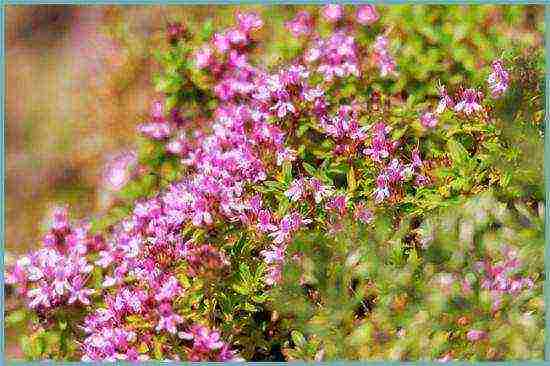
Variety "Kolkhida"
- "Donna Valley" - it grows with a dense carpet, the leaves are bordered by a yellow stripe, the flowering is constant pink;
- "Silver Queen" - forms a rather high (20 cm) loose carpet, gray leaves with white edging, densely arranged inflorescences have a lavender hue.
Creeping thyme belongs to the type of thyme, among which you can also find:
- Common thyme. A plant with a small growth of 5-10 cm. The leaves have a light down at the bottom. Flowering - white and pale lilac shade.
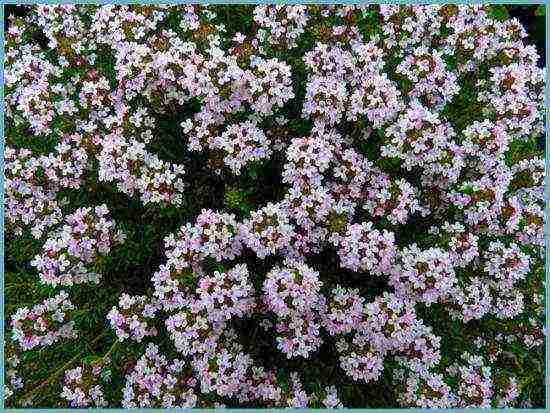
Thyme ordinary
- Lemon-scented thyme. It got its name due to its spicy aroma with subtle lemon notes, as well as the yellowish color of young leaves. The most popular varieties:
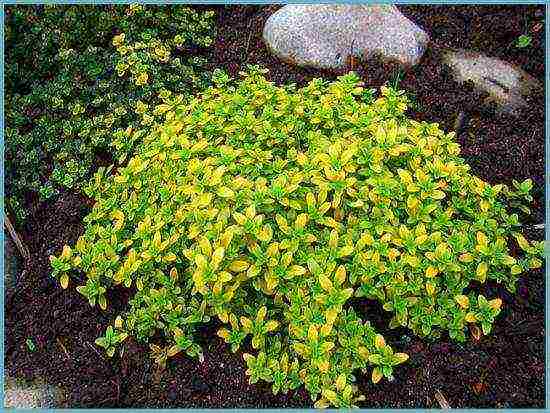
Lemon-scented thyme
- "Aurea" - has a bright yellow color;
- "Bertram Anderson" - has green leaves covered with yellow spots.
- Early thyme. It blooms earlier than others, but also fades a little faster. In our country, there are such varieties:

Early thyme
- "Minor" - has the slowest growth and small fluffy leaves;
- "Pseudolanuginosus" - has sharp green leaves with excessive pubescence, blooms very profusely.
Planting a plant
Thyme is grown on light, loose soil. Sunlight has a beneficial effect on its development, therefore, planting in open ground is carried out in a well-lit place.
In order for perennial plants to take root well, the site must be carefully dug up in the fall. And add organic fertilizer (compost or manure). In the spring, when the weather is warm outside with a temperature of at least 13 ° C, the soil is dug up again and seeds are sown.
Advice! After the thyme has been sown, you can sprinkle the seeds with river sand. It will provide young shoots with additional nutrients and prevent water from stagnating on the surface.
After the seedlings sprout and grow a little, it is necessary to thin out the planting. The ideal distance between plants is 30-35 cm.
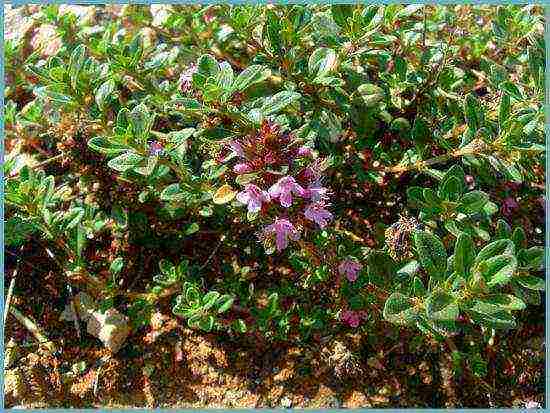
Fertilize and dig up the soil before planting thyme
In the open field, planting can also be carried out using seedlings. To do this, at the end of winter, thyme is sown in prepared trays. Watering the seedlings is carried out regularly, but not abundantly. Thyme rises under glass, which creates the effect of a greenhouse. After 3-4 weeks, the seedlings are taken out into the open air for hardening, and after another 2 weeks they are planted in a permanent place.
Thyme care
The first thing to do for the thyme after planting is to pin the tip of the stem, so the plant will form into a beautiful lush bush. Perennial crops need seasonal pruning. In autumn, when the flowering of thyme has stopped, it is necessary to shorten the bushes. In the new season, you will see how this procedure helped the plant to thicken and acquire a decorative shape.
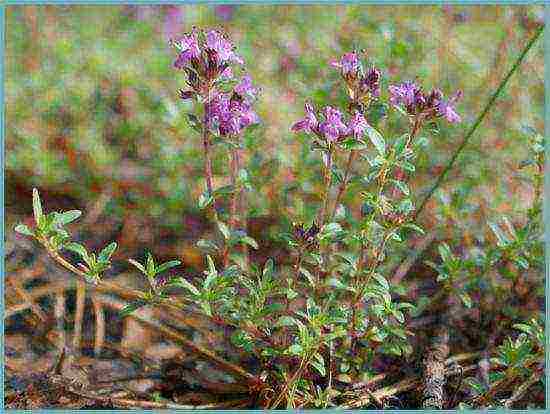
Shape the plant as it grows to create a beautiful bush.
It is very important for thyme to regularly weed and remove weeds, which draw out most of the nutrients from the soil. Since thyme is already growing rather slowly, "unwanted neighbors" will further inhibit its growth.
Caring for the plant also means watering it, which should be done no more than twice a week in dry weather and even less often if the summer is not very hot.
Important! Cover perennials with peat or fallen leaves for the winter.
Fertilization and feeding
It is undesirable for thyme to add fresh manure to the soil. Growing thyme outdoors allows the use of wood ash. It will not only add nutrients to the soil, but also reduce acidity.
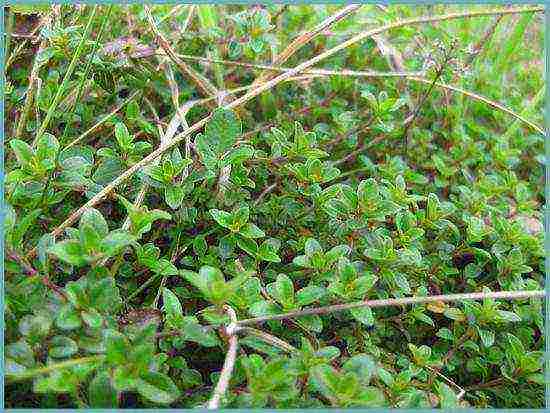
Feed perennials with mineral fertilizers
The first fertilization of thyme is carried out with urea in early spring. If this is the first year, then even before germination, and in the second and subsequent years with spring pruning.
Advice! Mineral fertilizers can be applied from the second year of life of creeping thyme.
Propagation of thyme
The propagation of varieties of creeping thyme in the open field is carried out in three ways:
- Seeds. The planting material is harvested in autumn and dried until spring. Then sow and cover with foil. Planting seeds in the fall is also allowed.
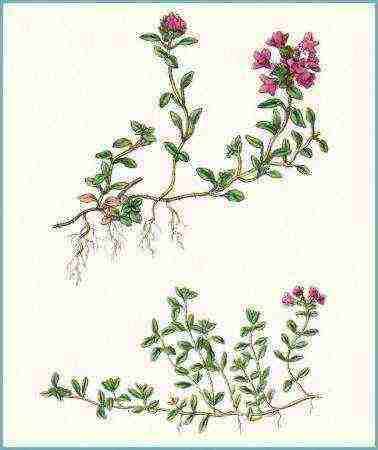
Pattern: thyme bush
- Cuttings. This method is convenient because the seedlings are already strong. Cuttings are selected for spring or autumn pruning. For planting, take the strongest of all. It is they who will subsequently form a new bush.
- By dividing the bush. A very painful method for the plant. When carrying out such a reproduction of thyme, the entire bush is dug up and divided in half. Special care is required. It is very important not to damage the root system, otherwise the plant may get sick or even die.
Diseases and pests
Creeping thyme is very resistant to attacks of pathogenic bacteria and pests. Planting and caring for him is not difficult. It is unpretentious, but its only drawback is its slow growth.
The main pests of the Bogorodskaya grass are:
- weevil;
- meadow moth;
- aphid;
- sandy slow.
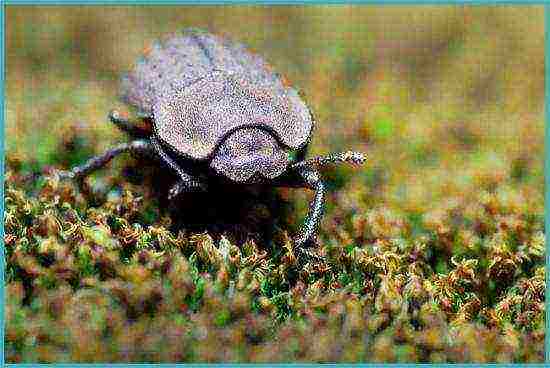
Sandy beetle
Thyme can also be affected by some fungal diseases. This is due to a violation of the cultivation technique. Excessive watering, rare weeding, shading of the plant lead to the spread of fungi on it.
Deep plowing, regular loosening of the root section of the soil, and timely weeding will save you from insect pests. Pests can also be removed by applying a fertilizer containing lime or other alkaline fertilizers.
Creeping thyme: combination with other plants
Thyme looks great in group or joint plantings. It can be used as a background for plants with large textured leaves. They often play on the contrast of colors in combination with geycher.
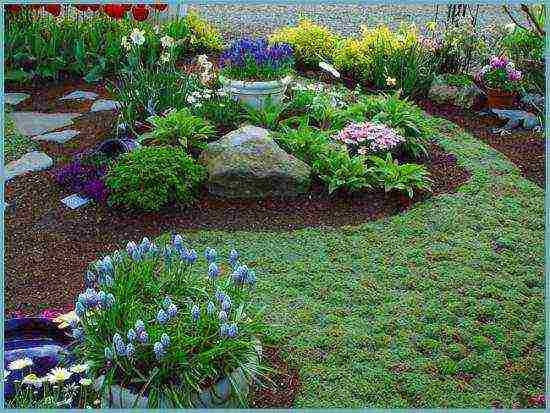
Thyme in landscape design
Thyme creeping with its powerful aroma attracts a large number of butterflies, bees and other pollinating insects. Therefore, it can be planted next to cucumber beds. Flying to the smell of thyme, the bees will help pollinate the rest of the vegetable crops.
Thyme or Bogorodskaya herb is the main component in the composition of bouquets made for the feast of the Holy Trinity. Such bundles also include wormwood, mint and lovage. Since ancient times, it was believed that the combination of their aromas will drive away all evil spirits from the dwelling.
Creeping thyme in landscape design
Being a low semi-shrub spreading along the ground, in landscape design, thyme is used as a background for alpine slides and mixboards. But he can act there and in the lead role. Looks very good on scree.
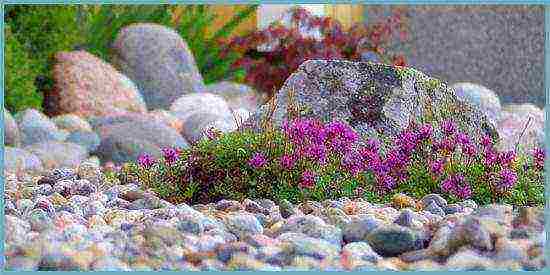
Rockery decoration with thyme
Growing creeping thyme will be a lot of fun for you. You will be able to enjoy not only the beautiful appearance of the fluffy pillow bushes, but also its wonderful spicy scent. And what bright and rich photos are obtained against the background of thyme - just a feast for the eyes.
Growing thyme: video
Varieties of thyme: photo
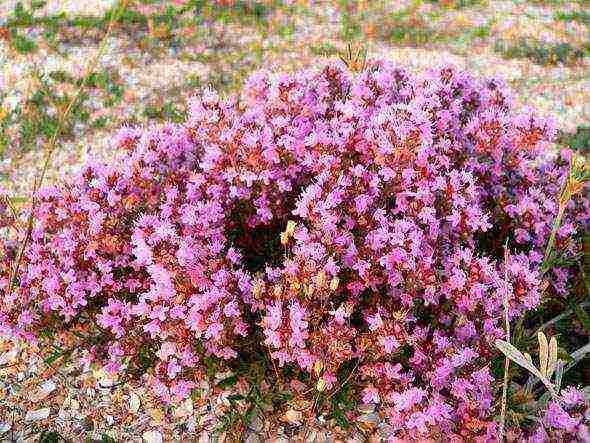
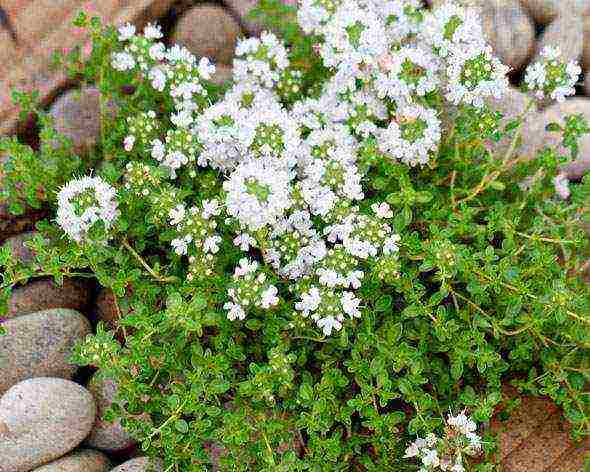
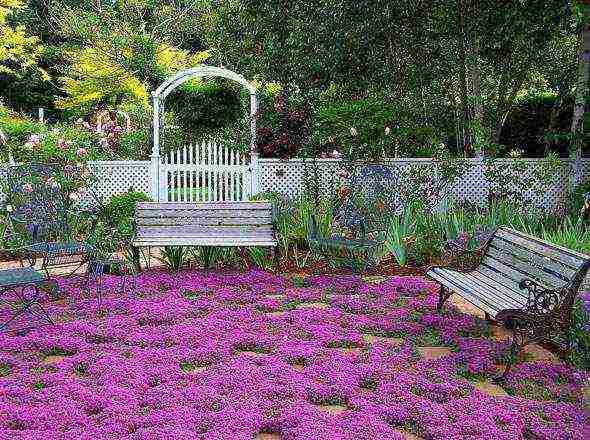
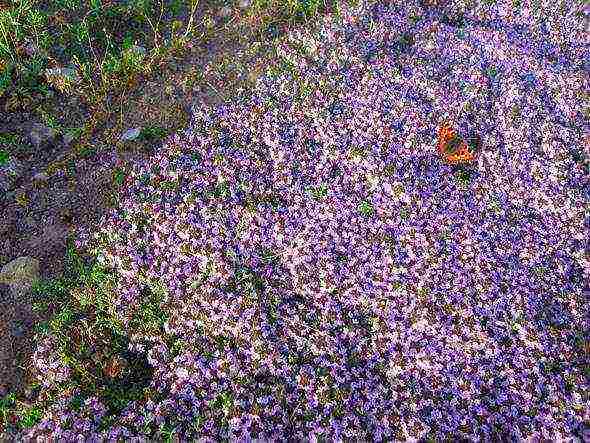
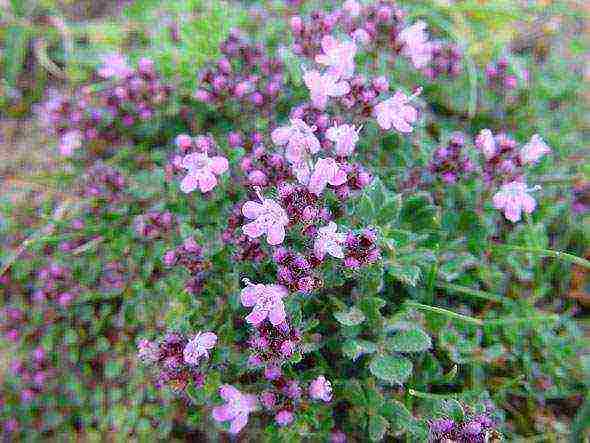
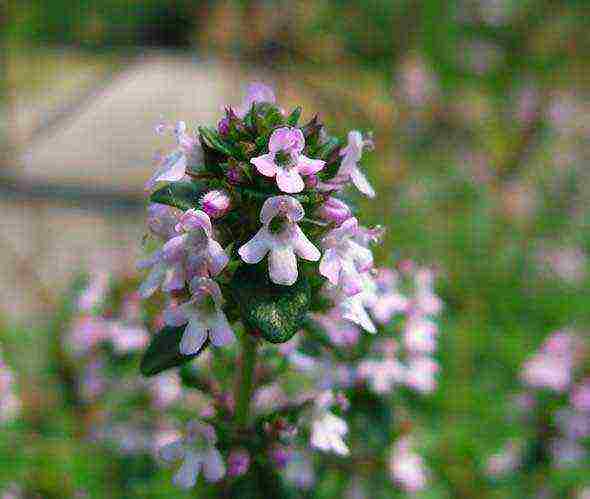
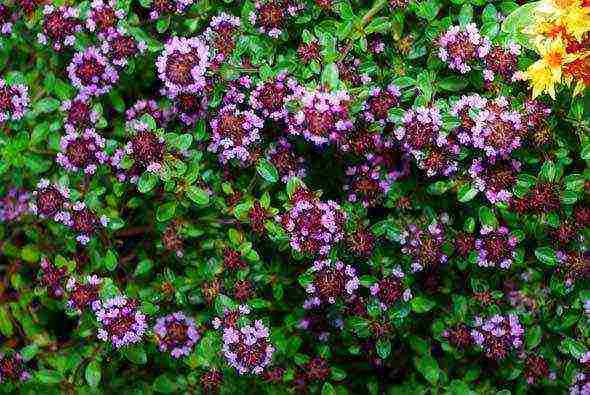
Thyme is a well-known perennial plant. It is a semi-shrub, reaching a height of forty centimeters, consisting of thin stems that grow along the ground. It has thin, small, oval-shaped green leaves. The flowers of the thyme are small and very pleasant with a pinkish-purple hue. They are located at the ends of the branches, forming bunches. The fruits of the plant are four nuts located at the base of the calyx. During flowering, the plant exudes a fragrant aroma, thereby attracting a large number of insects. Propagated both by seeds and vegetatively.

Thyme
The flowering period of the plant occurs in the first two months of summer. Fruits ripen in August and early September. The inhabitants of our country are familiar with this plant under different names. Among them: thyme, shaber, Bogorodskaya grass. This wonderful herb can be found in many regions of the Russian Federation: in its European part, in Kazakhstan, in the Caucasus, Transbaikalia, in the western part of Siberia, in Ukraine. Loves thyme forest ravines and slopes of gullies, prefers sandy soil. On arable land, it spreads over bumps and grows strongly.If the plant settles in spacious meadows, it forms huge thickets of striking pinkish as well as purple color.
Since the days of Avicenna, Roman warriors have used thyme for bathing to provide themselves with vigor and vitality. Our ancestors used this plant for rituals and treatment of diseases. With its help, they scared away evil spirits, cured children's fear, protected themselves from the evil eye and damage. And this herb got the name "Bogorodskaya" because since the time of ancient Russia, the icon of the Mother of God has traditionally been decorated with it. Today, thyme is widely used not only in the treatment of various diseases. Its taste and aroma qualities are widely used in cooking and cosmetology, thanks to its external attractiveness and pleasant aroma, it is happily bred by gardeners in their dachas and in flower beds. In addition, thyme is an excellent honey plant that bees love very much.
In the conditions of our country, three varieties of this plant are common: creeping, common and Marshall thyme. Thyme does not occur in the wild, it is a species cultivated by man. And the remaining two species can often be found in the wild.
How to grow thyme yourself
Due to its pleasant external data, unpretentiousness and the presence of many useful properties, thyme herb is a welcome inhabitant in every garden, dacha and vegetable garden. Bogorodskaya grass loves well-lit warm areas, tolerates shade, but it grows and looks worse there. Light soils with normal or slightly high acidity are well suited for the plant. Before planting, preparing the ground in the garden for winter, it is well dug up, weeds and roots, plant remains are removed. At the same time, ripe manure and fertilizers of phosphorus-potassium composition (double superphosphate) are introduced. In the middle of spring, the soil must be dug up again, broken up clods and urea added, about twenty grams. In a day, seeds can be sown on the soil surface, sprinkling them on top with a small layer of river sand, no more than one centimeter thick. It is better to plant the seeds in rows, so that the distance between them is about forty centimeters, and then cover with a film.
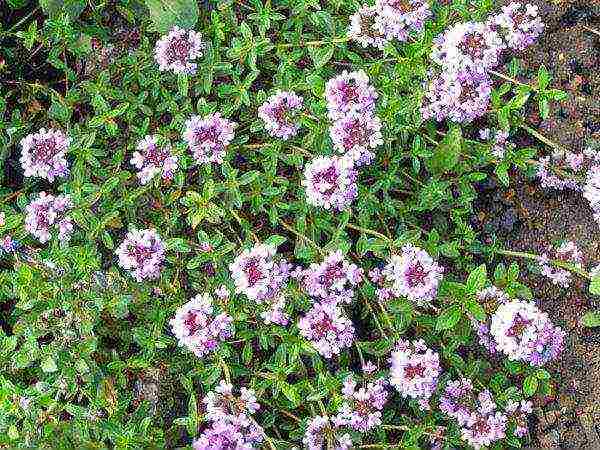
You can sow seeds often, and then thin out the seedlings by replanting the strongest growth to another area in the garden. This must be done in such a way that the distance between adjacent plants in a row is close to thirty centimeters. The most favorable temperature for seed germination is within twenty degrees Celsius. The first “sprouting” of sprouts can be seen in fifteen days.
The development of thyme is slow, so growing from seedlings is a completely acceptable method of breeding it. You need to start planting a flower in the second decade of March, observing the principle of surface distribution of seeds in special containers, as in the case of sowing in open garden soil. At the same time, it is better to mix the seed material with river sand or grind it with calcined sand, at the end of sowing. For planting seedlings in open ground, seventy-day seedlings are suitable. The rules for transferring it to garden soil are identical to growing from seeds.
Bogorodskaya grass can grow in one place within five years. For planting it, you can allocate a separate place in the garden, or you can grow a garden flower after vegetables.
Necessary care
It is not difficult to properly monitor thyme, its needs are not numerous, and caring for it does not require a lot of physical effort. It is necessary to occasionally weed the plant and loosen the soil around it. It is best to water frequently, but not too abundantly. This will prevent the soil from drying out and protect it from acidification. Bogorodskaya grass tolerates winter frosts well, but it is better to play it safe and cover in autumn with fallen leaves. Peat is also well suited for shelter and mulching.
The first top dressing with urea should be correctly applied in early spring. And when the greens are cut, it is better to use nitrogen phosphate fertilizers.Starting from the second season, it is good to feed the thyme in the spring with mineral fertilizers and liquid mullein. It is important to do it right - fresh manure can destroy the plant.
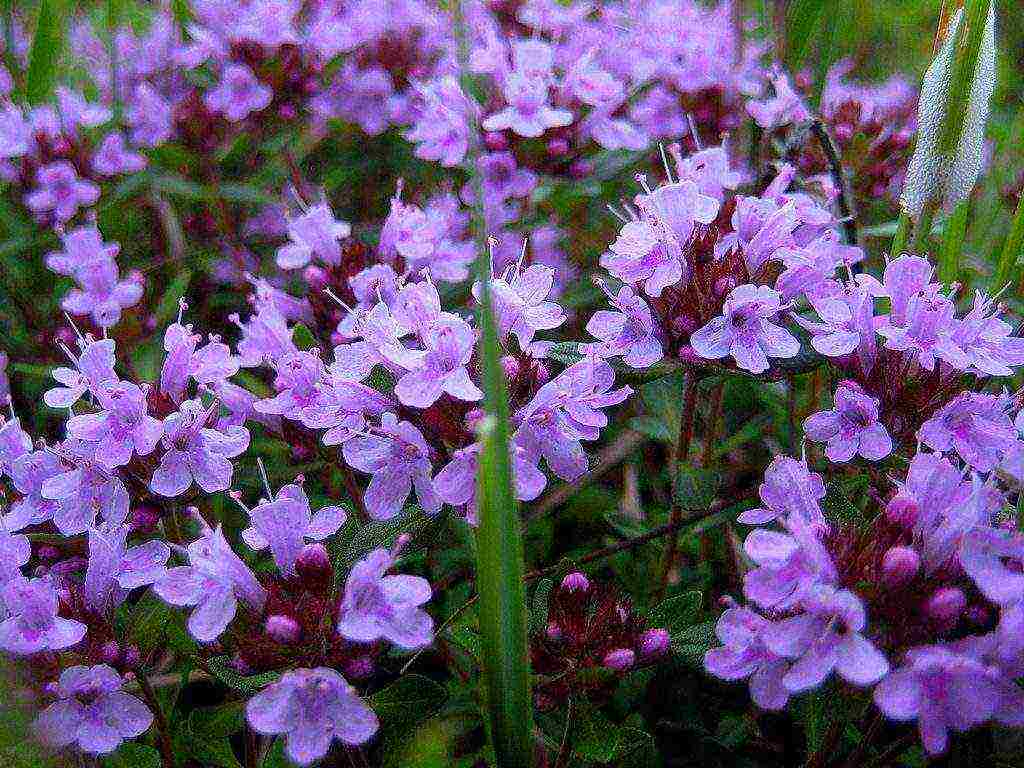
By pruning a garden flower at the woody level, dense and compact bushes can be formed.
Reproduction
Bogorodskaya grass reproduces equally well both by seeds and vegetatively: by dividing the bush and by cuttings. To propagate an old bush, it is dug out of the ground and carefully divided into smaller parts so as not to damage the roots and the ground part. Another way to plant thyme is to root the stem. For this purpose, annual creeping shoots are cut into several parts, up to five centimeters long. In the spring, they are planted in the ground under a jar or in a greenhouse. The rooting process takes approximately two weeks.
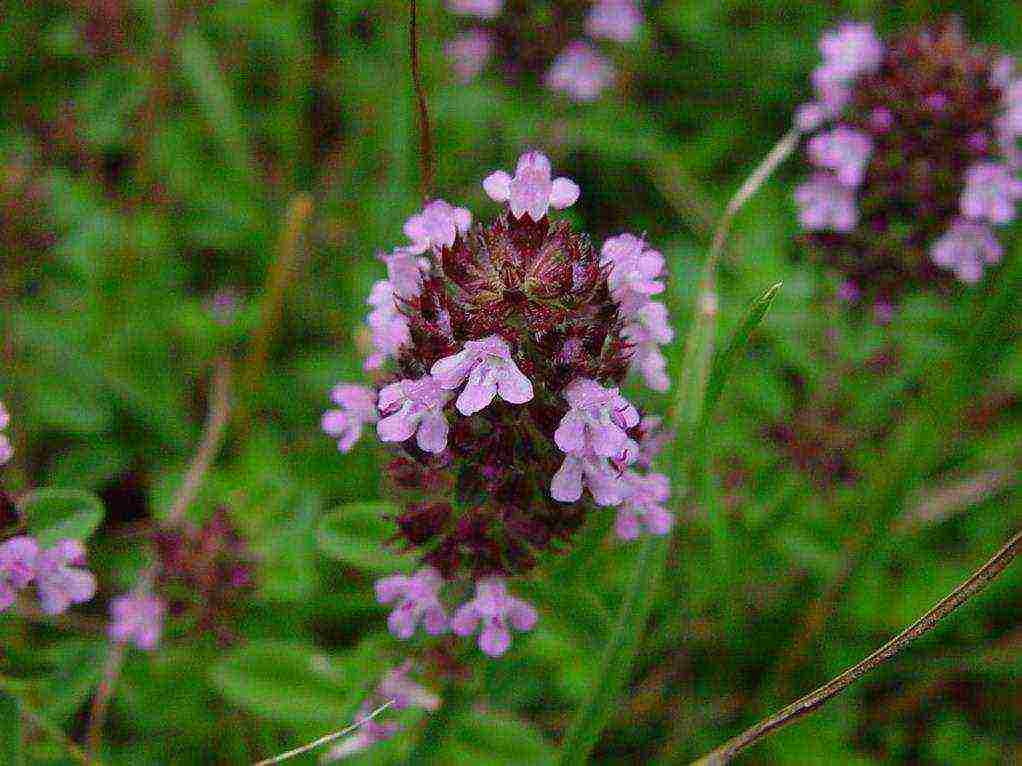
The advantage of seed propagation is that large plantations of flowers can be grown in this way.
When and how to harvest thyme
Traditionally, Trinity is considered the best time to harvest thyme. It is believed that Bogorodskaya grass accumulates the maximum healing qualities during this period.
The fragrant flower is carefully cut with a knife along with a leafy stem. And then it is dried according to the general rules: in a place protected from sunlight and in a well-ventilated place, spread out in a thin layer on a cloth or suspended in bunches under a roof.
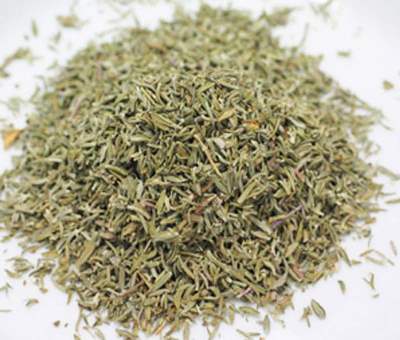
What is thyme afraid of?
In order to avoid decay of the roots of a young plant and acidification of the soil, it is very important to avoid stagnation of water in the first year of its growth. For the rest, thyme is resistant to various diseases and pests due to the presence of aromatic substances abundantly exuded by the flower. But, if the care of the plant is not sufficient, then such pests can affect it:
- Meadow moth - mainly affects stems and leaves. These pests are most active on summer nights. To combat it, insecticides are used.
- Sandy linger is a black beetle, up to one centimeter long. Affects all terrestrial parts of the plant. You can exterminate it using poisoned baits.
- Weevil is a black garden beetle, up to three millimeters long, affects young shoots and leaves, flower buds. You can get rid of it with the help of insecticides and poisoned baits.
- Aphids are small static insects that attack greenery and stems. Sensitive to insecticide.

Growing on a windowsill
Due to its unpretentiousness, Bogorodskaya grass is easily cultivated at home and requires minimal maintenance. With its help, your home will not only be decorated with beautiful flowers all autumn and winter, but there will always be a fresh aromatic seasoning and medicine available. You can plant a flower in the ground for growing cacti. In the spring, this can be done with the help of seeds, and in the fall, divide the shrub taken in the country or in the garden, and, after dividing it, plant it in a container a little more than the root system. Growing thyme in a pot will not be difficult if the main condition is met - good drainage.
Another important point is the choice of the location where the fragrant flower will be located. To do this, it is better to choose the sill of the south window, where the sun is the longest. In this case, the plant forms a dense bush with bright greenery. Under other conditions, the flower will stretch upward and will not become attractive even if excellent care is taken.
Thyme, he is
thyme
creeping, or "
Bogorodskaya grass
". It is no coincidence that he is called so: on the day of the Holy Trinity, houses are decorated with it, and on the feast of the Dormition of the Theotokos, he can be seen as a crown to the icon of the Theotokos.
Thyme
- a storehouse of useful substances. This herb has been widely used in Russia at all times. I myself often use it as a "help" for a child with a strong cough. On me
thyme tea
acts as an anti-fatigue, soothing agent. There is something unique and special in the smell of thyme.I confess that I have been using the thyme collected in the mountains of Karachay-Cherkessia for several years now, and I have planted it only this year.
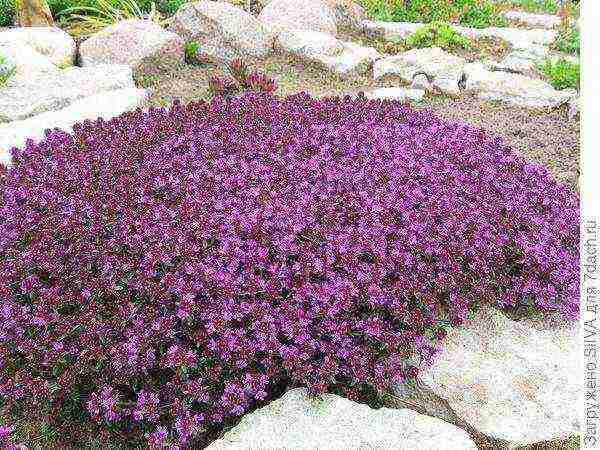
This plant belongs to family... The genus of thyme (Thymus) is complex, it includes low shrubs and semi-shrubs with pronounced aromatic properties.
Thyme is the richest "storehouse" of medicinal essential oil. Its stems are stiff, recumbent or erect. Their height is about 35 cm. Flowers at the ends of the inflorescences are collected in heads or small panicles. The color is quite varied: from white to pink, purple and even yellow.
I am attracted by its small flowers as an addition to other plants. But not only flowers are decorative. Thyme has unusual leaves. They can be oblong or rounded, of various sizes, with smooth or jagged edges. It is an excellent plant for alpine slides and rockeries.
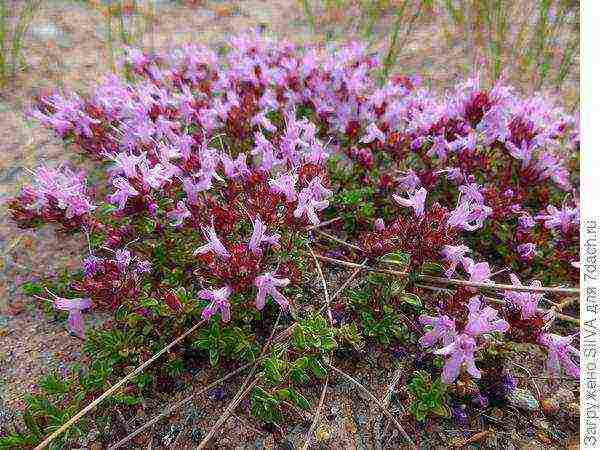
Not to be confused with thyme and savory, read more about this in the article of the same name.
We used to call thymecreeping thyme, but there are many more species and varieties that grow with us and are loved by gardeners. On the territory of our country, about 170 different types of thyme... The most popular and interesting you will find in the publication Thyme in your garden: species and varieties. It is worth planting several of them in your garden, and on a sultry evening, a wonderful smell will cheer you up.
Thyme is a fairly unpretentious plant, the main thing is to take into account the basic principles of its cultivation, and there will never be problems with it.
Planting thyme
Choose for thyme bright warm place, in the shade he feels worse. Thyme will perfectly complement the alpine slides, paths, and the surroundings of the decorative pond will take on a different look with it.
Preference should be given light, loose, not acidic soils.
- Dig up the soil well in the fall, removing the roots of weeds and extraneous plants from it.
- Apply compost or rotted manure, as well as phosphorus-potassium fertilizers. I brought in double superphosphate.
- In the spring, in mid-April, dig up the soil, break up the clods, add about 20 g of urea.
- The next day, sow seeds on the surface of the soil, sprinkling them with river sand on top (with a layer of about 1 cm). I recommend sowing in rows, taking about 40 cm between them.
- Cover with foil.
I sowed very often, I broke through unnecessary ones, planted the strongest of the broken seedlings in another place. At first they languished a little, but then they took root. There should be about 30 cm between plants in a row. The optimum temperature for friendly seedlings is about +20 ° С. In this case, it will take about 15 days from sowing to germination.
Thyme develops slowly, and its seeds are small, therefore, it is preferable for seed reproductionseedling method.
- Seedlings should be planted in the middle of March... In prepared containers, as well as in open ground, the seeds are not sealed, but distributed over the surface, sprinkled with calcined river sand from above or mixed with it.
- Good seedlings for planting in the ground should be about 70 days old.
- The scheme for planting plants in open ground is the same as for the non-seedling method.
Thyme predecessors there may be vegetables, but still it is worth allocating a separate place for it. He grows in this place for about 5 years.
Thyme care
Be sure to weed and loosen your plantings carefully. Water the thyme, but do not overflow. So that there is no dryness of the soil, but at the same time its acidification is excluded. Thyme is winter-hardy, but still I cover mine with fallen birch leaves.
I make the first top dressing in early spring in the form of urea. When you cut your greens, you can support your plant with Azophos. From the second year of life in the spring, you can feed the thyme with liquid mullein and mineral fertilizers. Need to know: thyme does not like fresh manure.
If you trim the thyme to the woody parts, the bushes will be leaner and denser.
Propagation of thyme
Thyme multiplies seeds and vegetatively (by cuttings and dividing the bush).
- When dividing, it is necessary to dig out the bush and carefully, without injuring the roots, divide it into parts.
- You can root the cuttings. To do this, creeping annual shoots must be cut into pieces of about 5 cm and root them in the spring under a jar or in greenhouse conditions. Avoid souring and excessive moisture so that the plant does not rot. After a couple of weeks, the cutting will take root.
The advantage of seed propagation is that a large number of plants can be obtained with it.
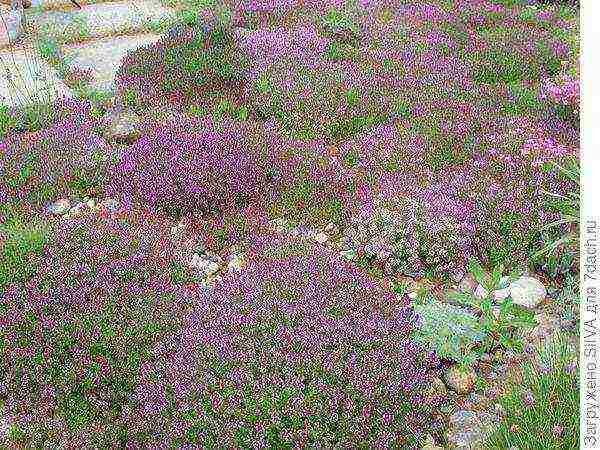
Collection of thyme
By tradition, thyme is harvested on Trinity. It was believed that it was on this day that thyme has the maximum healing effect.
The raw materials are collected during the flowering period. Leafy twigs are cut with a sharp knife. Do not damage the plant by breaking and pulling it off. You can easily pull it out, but it will take effort to grow back.
It dries in the same way as most herbs. Unfolds on fabric or burlap, without direct sunlight, or in bunches under the ceiling of the attic.


